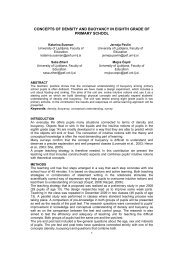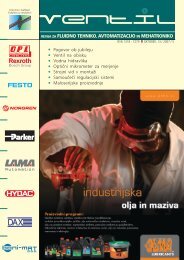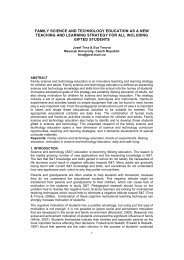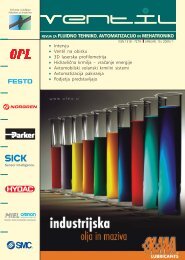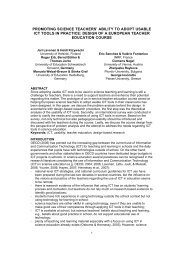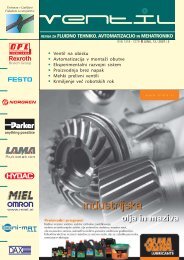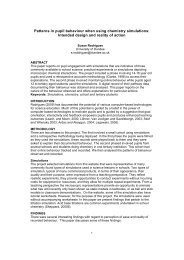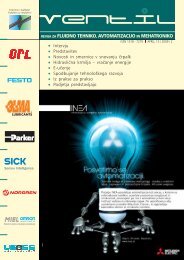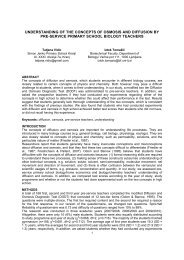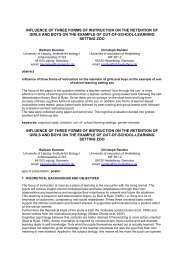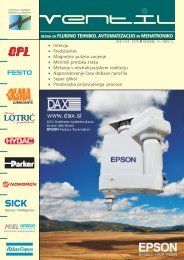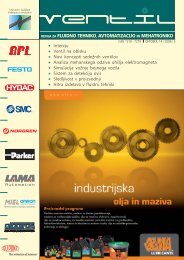1. PDF dokument (13 MB) - dLib.si
1. PDF dokument (13 MB) - dLib.si
1. PDF dokument (13 MB) - dLib.si
- No tags were found...
You also want an ePaper? Increase the reach of your titles
YUMPU automatically turns print PDFs into web optimized ePapers that Google loves.
DISKRETNA SIMULACIJAdepending tasks in collaboration withother actors. It is understandable thatall levels of the clas<strong>si</strong>cal hierarchy ofcontrol theory must be present in<strong>si</strong>deeach performer of a product or aresource [12].The proposed decentralized approach<strong>si</strong>mplifies control of a manufacturingsystem. It as<strong>si</strong>gns a particularimportance to events that involveactions [12]. Autonomy, which isgiven to each module, results in thelocal ability to deal with disturbancesand, consequently, the system reactsphy<strong>si</strong>cally as close as pos<strong>si</strong>ble tothe place where events occur [<strong>13</strong>].Furthermore, with this approach, architectureof a control system allowscomplete integration of all controllevels into a homogeneous, modularand open structure.2.3 Self-scheduling andcontrol, driven by theproductProduct (context of ‘product’: cf.section 2, paragraph 2) is an ordergiverin proposed control for manufacturing.The product negotiateswith production resources or servers,to determine the best productionschedule.Products (sub-products, parts) areable to not only organize and controltheir behavior, but also to controlthe machines. Each product keepsan agenda in which it records operationsto be carried out, for its’ flowof production. For each operation theidentity of the server, the time stampsof start and end are recorded. Resourcesare also autonomous and are ableto accept or to refuse order-givers’request. They have their own agendas.In order to avoid combinatoryexplo<strong>si</strong>on and to reduce computingtime, a product searches for shortestoperation time for two or three consecutiveoperations only. In case of adisruption, autonomous entities reactrapidly and locally. Appointmentswith the stopped machine are cancelledand the products search foranother machine.A product is negotiating appointmentsfor its’ manufacturing <strong>si</strong>nce itVentil 14 /2008/ 3is equipped with the information onits’ sequence of operations and theirapproximate duration, its’ due dateand its’ production progress. It alsoknows the suitable resources for eachoperation. The negotiation protocol isthe following:<strong>1.</strong> For the first operation to carry out,the product communicates withall suitable resources and makesa provi<strong>si</strong>onal appointment. A startdate and an end date are negotiated.The product takes into accountthe transportation time andthe resource takes into account itspotential setup time.2. For the next operation, it communicateswith all the suitableresources and makes provi<strong>si</strong>onalappointments. As a result, theproduct obtains one or moreappointment sequences for twoconsecutive operations. It cancommunicate further and makeprovi<strong>si</strong>onal appointmen ts for nextremaining operations.3. Then, the product chooses thebest sequence of operationsand communicates with all themachines to confirm the chosenappointments and to cancel theothers.If a breakdown occurs, the affectedautonomous entities react locallyand quickly: the appointments witha stopped machine are cancelledand the product tries to find anothermachine [14].When conflicts in search for appointmentsdo arise, a product with thehighest as<strong>si</strong>gned priority makes itsappointment before others can. Manystandard deci<strong>si</strong>on rules may be used:FIFO (First In First Out), LIFO (LastIn, First Out), SPT (Shortest Proces<strong>si</strong>ngTime), EDD (Earliest Due Date),MOR (Most Operation Remaining),FOR (Fewest Operation Remaining),and others.2.4 Quality of solutions andfunctions of supervi<strong>si</strong>onEach product and each resource aimat satisfying its own criteria. The qualityof the global solution (in terms ofproductivity) depends on the propersucces<strong>si</strong>on of all the operations forall the products on all the resourcesof the manufacturing system. Productsand resources do not take intoaccount the global state of the systemand only solve local problems.However, the presented negotiationprotocol allows consecutive operationsto be linked to find favorablesequences, to control waiting timefor the products, to control idle andsetup time for resources and to controltransport time.An almost just-in-time behaviorwith a steady flow of production isexpected, even if it cannot be absolutelydemonstrated (in the currentstate of our work and other knownwork). Effectively, with the appointmentmechanism and with the useof priority rules, each product isprogrammed to progress as fast aspos<strong>si</strong>ble and each resource is to sequenceoperations with a minimumlost time.3 Simulation of productionin a Robotic cell and resultsThis approach has been validated byqueuing <strong>si</strong>mulation [15]. All entities(products and machines) have beenrepresented as objects (literally, itis object programming that is usedin the <strong>si</strong>mulation). The objects possessthe necessary information forcommunication, negotiation anddeci<strong>si</strong>on. Simulation of activities andevents gives us in<strong>si</strong>ght into workingsof a proposed manufacturing system,either with or without disturbances.We modeled the prototype of anFMS, which is shown in Figure 3 below.This system con<strong>si</strong>sts of:– an automated storage and retrievalsystem (AS/RS),– a storekeeper robot (R1),– three process robots (R2-R4),– four belt conveyors (a conveyorfor each robot),– a central conveyor.The assumptions are that:– the robots are able to carry out<strong>si</strong>x different operations with aspecific tool, operations have adifferent setup time and a differentproces<strong>si</strong>ng time,– the operation process is madeup of no more than <strong>si</strong>x different247



